List of paleontologists
- This is an incomplete list that may never be able to satisfy particular standards for completeness. You can help by expanding it with reliably sourced entries.
This is a list of notable paleontologists who have made significant contributions to the field of paleontology.
A
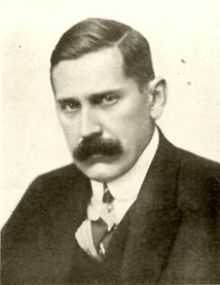
Othenio Abel
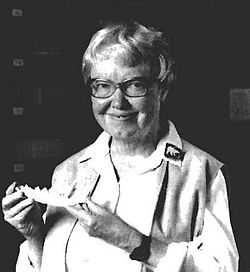
Elaine Anderson
- Othenio Abel (Austria, 1875-1946), considered to be a founder of paleobiology
- William Abler (USA)
- Karel Absolon (Czech Republic, 1877-1960)
- Gustava Aigner (Austria, 1906-1987)
- Truman H. Aldrich (USA, 1848-1932)
- Annie Montague Alexander (Kingdom of Hawaii / USA, 1867-1950), established the University of California Museum of Paleontology
- John Alroy (USA / Australia, 1966- )
- Carlos Ameghino (Argentina, 1865–1936)
- Florentino Ameghino (Argentina, 1854-1911)
- Charles Anderson (Scotland / Australia, 1876-1944)
- Elaine Anderson (USA, 1936-2002)
- Charles William Andrews (England, 1866-1924)
- Henry Nathaniel Andrews (USA, 1910-2002), paleobotanist specializing in Devonian and Carboniferous plants
- Mahala Andrews (Scotland, 1939-1997)
- Roy Chapman Andrews (USA, 1884-1960), known for expeditions in China and Mongolia during the early 20th century
- Ernesto Pérez d'Angelo (Chile, 1932-2013)
- Mary Anning (England, 1799-1847), known for important finds she made in Jurassic marine fossil beds in the cliffs along the English Channel at Lyme Regis
- Richard Aldridge (England, 1945-2014)
- Camille Arambourg (France, 1885-1969), vertebrate paleontologist
- Edward Alexander Newell Arber (England, 1870-1918)
- Adolphe d'Archiac (France, 1802-1868)
- William Joscelyn Arkell (England, 1904-1958), known for work on Jurassic Period
- Chester A. Arnold (USA, 1901-1977)
- Berhane Asfaw (Ethiopia), co-discovered remains of Homo sapiens idaltu
- Hermann Martin Asmuss (Estonia, 1812 – 1859)
- Walter Auffenberg (USA, 1928-2004), known for study of reptiles
- Stanley Awramik (USA, 1946- ), known for Precambrian-related work
B

Robert T. Bakker
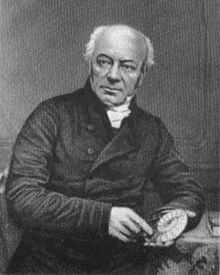
William Buckland
- William Hellier Baily (England, 1819-1888)
- Robert T. Bakker (USA, 1945- )
- Jean-Christophe Balouet (France, 1956- )
- Mário Costa Barberena (Brazil, 1934 – 16 December 2013)
- Erwin Hinckly Barbour (USA, 1856-1947)
- Joachim Barrande (France, 1799-1883)
- Charles Barrois (France, 1851-1939)
- Rinchen Barsbold (Mongolia, 1935- )
- Ray S. Bassler (USA, 1878-1961)
- Dorothea Bate (England, 1878-1951)
- Francis Arthur Bather (England, 1863-1934)
- Georg Baur (USA, 1859-1898), vertebrate paleontologist
- George Bax Holmes (England, 1803-1887)
- Allan Bé (USA, died 1983)
- William Bean (England, 1787-1866)
- K. Christopher Beard (USA)
- William Beard (England, 1772-1868), bone collector
- Günter Bechly (Germany, 1963- ), fossil insect specialist
- Samuel Beckles (England, 1814-1890)
- Charles Emerson Beecher (USA, 1856-1904), studied trilobite ventral anatomy from specimens collected at Beecher's Trilobite Bed
- Hermann Behmel (Germany, 1939- )
- Kay Behrensmeyer (USA)
- Walter A. Bell (Canada, 1889-1969)
- Romeu Beltrão (Brazil, 1913-1977)
- Etheldred Benett (England, 1776-1845), collecting and studying fossils of South West England
- Michael Benton (Scotland, 1956- )
- Georg Karl Berendt (Germany, 1790-1850)
- Wolfgang H. Berger (Germany / USA, 1937- ), oceanographer, geologist and micropaleontologist
- Charles Eugène Bertrand (France, 1851-1917)
- Paul Bertrand (France, 1879-1944)
- Heinrich Ernst Beyrich (Germany, 1815-1896)
- Peter von Bitter (Canada)
- Alexander Bittner (Austria, 1850-1902)
- Philip R. Bjork (USA), known for work on dinosaurs
- Richard S. Boardman (USA, 1923-2011), known for work on bryozoans
- Johannes Böhm (Germany, 1857-1938)
- José Bonaparte (Argentina, 1928- )
- Matthew Bonnan (USA), vertebrate paleontologist
- Pramatha Nath Bose (India, 1855–1934)
- Marcellin Boule (France, 1861-1942)
- Michael Boulter (England, 1942- )
- James Scott Bowerbank (England, 1797-1877)
- Henry Bowman Brady (England, 1835-1891), micropaleontologist
- Wilhelm von Branca (Germany, 1844-1928)
- Leonard R. Brand (USA, 1941- )
- Martin Brasier (England, 1947-2014)
- Auguste Bravard (France, 1803-1861)
- William J. Breed (USA, 1928-2013)
- Stoycho Vassilev Breskovski (Bulgaria, 1934-2004)
- Derek Briggs (Ireland / USA, 1950)
- Pierce Brodkorb (USA, 1908-1992)
- Adolphe-Théodore Brongniart (France, 1801-1876)
- Heinrich Georg Bronn (Germany, 1800-1862)
- Robert Broom (Scotland / South Africa, 1866-1951)
- Barnum Brown (USA, 1873-1963), discovered the first documented remains of Tyrannosaurus rex
- Michel Brunet (France, 1940- ), known for discovery of Toumaï
- Stephen L. Brusatte (USA, 1984- ), specializes in anatomy and evolution of dinosaurs
- Christian Leopold von Buch (Germany, 1774-1853)
- Walter Hermann Bucher (Germany / USA, 1888-1965)
- Mary Buckland (England, 1797-1857)
- William Buckland (England, 1784-1856)
- Graham Budd (England, 1968- )
- Oliver Bulman (England, 1902-1974)
- Emanuel Bunzel (Austria, 1828-1895)
- George Busk (England, 1807-1886)
- Charles Butts (USA, 1863-1946)
C
.jpg)
Mary Gordon Calder
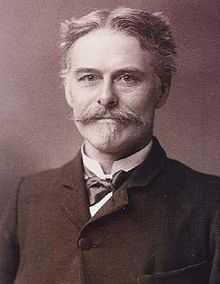
Edward Drinker Cope
- Susan Cachel (USA)
- Jaci Antonio Louzada Tupi Caldas (Brazil, 1898-1946)
- Mary Gordon Calder (Scotland, 1906–1992)
- André Cailleux (France, 1907-1986)
- Jorge O. Calvo (Argentina, 1961- )
- Ferdinand Canu (France, 1863-1932)
- Adriaan Gilles Camper (Netherlands, 1759-1820)
- Daniel Cargnin (Brazil, 1930-2002)
- Kenneth Carpenter (Japan, 1949- )
- Robert L. Carroll (USA, 1938- ), vertebrate paleontologist specializing in Paleozoic and Mesozoic amphibians and reptiles
- Rodolfo Casamiquela (Argentina, 1932-2008), known for his discovering of dinosaur Pisanosaurus mertii in 1967
- Ermine Cowles Case (USA, 1871-1953)
- Meemann Chang (China, 1936- )
- Frederick Chapman (England / Australia, 1864-1943)
- Wilfrid Chapman (England, 1891-1955)
- Edward Charlesworth (England, 1813-1893)
- Sankar Chatterjee (USA), has focused on the origin, evolution, functional anatomy, and systematics of Mesozoic vertebrates, including basal archosaurs, dinosaurs, pterosaurs, and birds
- James Chatters (USA, 1949- )
- Alan Cheetham (USA, 1928- )
- Luis M. Chiappe (Argentina), codescribed the world's first pregnant plesiosaur specimen
- Karen Chin (USA)
- Anusuya Chinsamy-Turan (South Africa), known for her expertise and developments in the study of the microstructure of fossil teeth and bones of dinosaurs
- Henry Christy (England, 1810-1865)
- Jenny Clack (England, 1947- ), known for study of fish evolution
- T. H. Clark (Canada, 1893-1996)
- John Mason Clarke (USA, 1857-1928)
- Preston Cloud (USA, 1912–1991), known for his works on the significance of Cambrian fossils in the 1940s led to the development of the concept "Cambrian explosion"
- Richard Cloutier (Canada)
- Edwin Harris Colbert (USA, 1905–2001)
- William Conybeare (England, 1787-1857), known for work on marine reptile fossils
- Isabel Clifton Cookson (Australia, 1893-1973), specialised in palaeobotany and palynology
- Desmond H. Collins (Canada)
- Edward Drinker Cope (USA, 1840-1897), paleontologist and comparative anatomist, as well as a noted herpetologist and ichthyologist
- Rodolfo Coria (Argentina, 1959- )
- Maurice Cossmann (France, 1850-1924)
- Joseph Pitty Couthouy (USA, 1808-1864)
- Carlos de Paula Couto (Brazil, 1910-1982), specialized in study of mammals
- Leslie Reginald Cox (England, 1897-1965)
- Henry Crampton (USA, 1875-1956), specialized in the study of land snails
- Carl Hermann Credner (Germany, 1841-1913)
- Irene Crespin (Australia, 1896-1980)
- Walter Drawbridge Crick (England, 1857-1903)
- Margaret Crosfield (England, 1859-1952)
- Osvaldo Rodrigues da Cunha (Brazil, 1930-2011)
- Ethel Currie (Scotland, 1899-1901)
- Philip J. Currie (Canada, 1949- )
- Kristina Curry Rogers (USA), vertebrate paleontologist
- Georges Cuvier (France, 1769-1832), considered influential in the development of vertebrate paleontology
D
Louis Dollo
- Ted Daeschler (USA), specialist in fish paleontology, especially in the late Devonian period
- Anne Dambricourt-Malassé (France, 1959- )
- Wilhelm Dames (Germany, 1843-1898),
- Robert Damon (England, 1814-1889)
- Thomas Davidson (Scotland, 1817-1885)
- A. Morley Davies (England)
- William Davies (England, 1814-1891)
- John William Dawson (Canada, 1820–1899)
- Mary R. Dawson (USA)
- Henry De la Beche (England, 1796-1855), pioneered early geological survey methods
- Tao Deng (China, 1963- ), made important fossil discoveries of Cenozoic mammals
- Charles Depéret (France, 1854-1929)
- Peter Dodson (USA), known for work regarding ceratopsians, hadrosaurs, and sauropods
- Louis Dollo (France / Belgium, 1857–1931)
- Dong Zhiming (China, 1937- ), vertebrate paleontology
- Philip Donoghue (England)
- Stephen Donovan (England, 1954- )
- François Doumergue (France, 1858-1938)
- Joseph Henri Ferdinand Douvillé (France, 1846-1937)
- Eugène Dubois (Netherlands, 1858-1940), known for work on hominids
- Émilien Dumas (France, 1804-1873)
- William Sutherland Dun (Australia, 1868-1934)
- Carl Owen Dunbar (USA, 1891-1979), invertebrate paleontologist
- Peter Martin Duncan (England, 1824-1891)
- Wilhelm Dunker )Germany, 1809-1885)
- Gareth J. Dyke (Ireland)
E
- Tilly Edinger (Germany / USA, 1897-1967), founder of paleoneurology
- Dianne Edwards (England, 1942- ), palaeobotanist studying the colonisation of land by plants
- Sir Philip Grey Egerton, 10th Baronet (England, 1806-1881)
- Niles Eldredge (USA, 1943- ), proposed theory of punctuated equilibrium
- Ashton F. Embry (Canada, 1946- )
- Cesare Emiliani (Italy / USA, 1922-1995), founder of paleoceanography
- Douglas Emlong (USA, 1942-1980), amateur fossil collector from the Oregon Coast
- Hermann Friedrich Emmrich (Germany, 1815-1879)
- Michael S. Engel (USA, 1971- )
- Bruce Erickson (USA, 1933- ), known for Paleocene research
- Gregory M. Erickson (USA)
- Gundolf Ernst (Germany, 1930-2002)
- Douglas Erwin (USA)
- Robert Etheridge (England, 1819-1903)
- Robert Etheridge, Junior (England / Australia, 1847-1920)
- Constantin von Ettingshausen (Austria, 1826-1897), paleobotanist
- Eugène Eudes-Deslongchamps (France, 1830-1889)
- Jacques Amand Eudes-Deslongchamps (France, 1794-1867)
- Susan E. Evans (England)
F
- Hugh Falconer (Scotland, 1808-1865)
- Paul Fallot (France, 1889-1960)
- Carroll Lane Fenton (USA, 1900-1969)
- Mildred Adams Fenton (USA, 1899-199)
- Mikhail Fedonkin (Russia, 1946- )
- Clive Finlayson (Gibraltar, 1955- )
- Geraldine Finlayson (Gibraltar,
- Anthony Fiorillo (USA)
- Paul Henri Fischer (France, 1835-1893)
- Tim Flannery (Australia, 1956- )
- Rousseau H. Flower (USA, 1913-1988)
- August Foerste (USA, 1862-1936)
- Michael Foote (USA, 1963- )
- Edward Forbes (Isle of Man, 1815–1854)
- Mikael Fortelius (Finland, 1954- )
- Catherine Forster (USA)
- Clive Forster-Cooper (England, 1880-1947), known for description of Paraceratherium
- Richard Fortey (England, 1946- )
- William Parker Foulke (USA, 1816-1865), discovered the first dinosaur skeleton in North America
- William Fox (England, 1813-1881)
- Childs Frick (USA, 1883-1965), vertebrate paleontologist
- Antonin Fritsch (Czech Republic, 1832-1913)
G
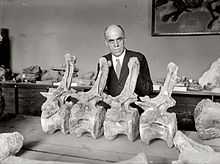
Charles W. Gilmore
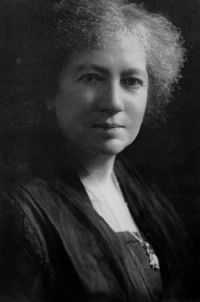
Maria Gordon
- William More Gabb (USA, 1839-1878)
- Eugene S. Gaffney (USA)
- Peter Galton (England, 1942- ), vertebrate paleontologist known for study of ornithischian and prosauropod dinosaurs
- Taiping Gao (China, 1984- )
- Kenneth Garrett (USA, 1953- ), photographer specializing in archaeology and paleontology
- Jean Albert Gaudry (France, 1827-1908)
- Jacques Gauthier (USA)
- Charles Lewis Gazin (USA, 1904—1995), vertebrate paleontologist
- Henry Gee (England, 1962- )
- Paul Gervais (France, 1816-1879)
- James W. Gidley (USA, 1866-1931)
- Edmund Dwen Gill (Australia, 1908-1986)
- David Gillette (USA)
- Charles W. Gilmore (USA, 1874-1945), vertebrate paleontologist
- Philip D. Gingerich (USA, 1946- ), known for research focusing on the Paleocene-Eocene transition and early Cenozoic mammals
- George Herbert Girty (USA, 1869–1939)
- Bernard du Bus de Gisignies (Netherlands / Belgium, 1808-1874)
- Martin Glaessner (Austria-Hungary / Australia, 1906-1989)
- Ludwig Glauert (England / Australia, 1879-1963)
- Pascal Godefroit (Belgium)
- Mackenzie Gordon, Jr. (USA, 1913–1992), invertebrate paleontologist specializing in Carboniferous fossils
- Maria Gordon (Scotland, 1864–1939)
- Dragutin Gorjanović-Kramberger (Croatia, 1856-1936)
- Stephen Jay Gould (USA, 1941-2002), contributed to theory of punctuated equilibrium and known for popular science relating to evolution and paleontology
- David J. Gower (England)
- Amadeus William Grabau (USA / China, 1870-1946)
- Bruno Granier (France)
- Walter W. Granger (USA, 1872-1941), vertebrate paleontologist
- Richard E. Grant (USA, 1927-1995), known for study of Permian brachiopods
- Joseph T. Gregory (USA, 1914-2007)
- William King Gregory, (USA, 1876-1970)
- David Grimaldi (USA, 1957- )
H
- George Haas (Austria, 1905-1981)
- Jules Haime (France, 1824-1856)
- James Hall (USA, 1811-1898)
- Anthony Hallam (England, 1933- ), concentrated on Jurassic Period
- Beverly Halstead (England, 1933-1991)
- David Harper (England), specialized in brachiopods and numerical paleontology
- Tom Harris (England)
- John Bell Hatcher (USA, 1861-1904), best known for discovering Torosaurus
- Sidney H. Haughton (England / South Africa, 1888–1982)
- Oliver Perry Hay (USA, 1846-1930)
- Angelo Heilprin (USA, 1853-1907)
- Sam W. Heads (England, 1983- )
- Oswald Heer (Switzerland, 1809–1883)
- Gerhard Heilmann (Denmark, 1859-1946), known for artistic depictions of prehistoric birds
- Sue Hendrickson (USA, 1949- )
- Victoria Herridge (England)
- Edward Hitchcock (USA, 1793–1864)
- Scott Hocknull (Australia), vertebrate paleontologist
- Johann Leonard Hoffmann (Netherlands, 1710–1782)
- Hans J. Hofmann (Germany / Canada, 1936-2010)
- William Jacob Holland (USA, 1848-1932)
- J. Alan Holman (USA, 1931-2006), known for his 1995 work called Pleistocene Amphibians and Reptiles in North America
- Keith Holmes (Australia), paleobotanist
- Thomas R. Holtz, Jr. (USA, 1965- ), vertebrate paleontologist
- James Hopson (USA, 1935- ), known for work on evolution of synapsids
- Dirk Albert Hooijer (Netherlands, 1919-1993)
- Reginald Hooley (England, 1865-1923)
- Jack Horner (USA, 1946- )
- Moritz Hornes (Austria, 1815-1868)
- Nicholas Hotton III (USA, 1920/21-1999), expert on dinosaurs and reptiles
- Hildegarde Howard (USA, 1901-1998), pioneer in the field of avian paleontology
- Jean Jacques Nicolas Huot (France, 1790-1845)
- Julian P. Hume (England, 1960- )
- Pierre Hupé (France, 1907-2003)
- Thomas Henry Huxley (England, 1825-1865)
- Alpheus Hyatt (USA, 1838-1902)
I
- Thomas Image (England, 1772–1856)
J
- David Jablonski (USA, 1953- )
- Louis L. Jacobs (USA, 1948- ), vertebrate paleontologist
- Sohan Lal Jain (India)
- Helen F. James (USA, 1956- ), known for extensive publications on fossil birds of the Hawaiian islands
- Philippe Janvier (France)
- Dick Jefferies (England)
- Farish Jenkins (USA, 1940-2012)
- James A. Jensen (USA, 1918-1998)
- Kirk Johnson (USA, 1960- )
- Frederik Johnstrup (Denmark, 1818-1894)
- Thomas Rupert Jones (England, 1819-1911)
K
- Josephine Kablick (Czech Republic, 1787-1863)
- Myra Keen (USA, 1905–1986), invertebrate paleontologist
- Gerta Keller (USA, 1945- )
- Alexander Kellner (Brazil, 1961- )
- Remington Kellogg (USA, 1892-1969)
- Doris Kermack (England, 1923-2003)
- Kenneth Kermack (England, 1919-2000)
- Caitlín R. Kiernan (USA, 1964- )
- Gillian King (England)
- William King (Ireland / England, 1809-1886), first to propose bones found in Neanderthal, Germany were of a distinct species from humans, Homo neanderthalensis
- James Kirkland (USA, 1954- )
- Andrew H. Knoll (USA, 1959- )
- Gustav Heinrich Ralph von Koenigswald (Germany / Netherlands, 1902-1982)
- Anastas Kondo (Albania, 1937-2006), micropaleontologist
- Andreas Kornhuber (Austria, 1824-1905), known for dinosaur investigations
- Laurent-Guillaume de Koninck (Belgium, 1809-1887)
- Jaroslav Kraft (Czech Republic, 1940-2007), specialist in Ordovician graptolites
- Björn Kurtén (Finland, 1924-1988), vertebrate paleontologist
L
- Kenneth Lacovara (USA)
- Matt Lamanna (USA)
- Lawrence Lambe (Canada, 1863–1919)
- Charles Lamberton (France, 1876–1960), specialized in recently extinct subfossil lemurs
- Archibald Lamont (Scotland, 1907-1985)
- Wann Langston, Jr. (USA, 1921-2013)
- Jia Lanpo (China, 1908-2001)
- Albert-Félix de Lapparent (France, 1905–1975)
- Peter Larson (USA, 1952- )
- Édouard Lartet (France, 1801-1871)
- Louis Lartet (France, 1840-1899)
- Gustav Karl Laube (Germany / Czech Republic, 1839-1923)
- Charles Léopold Laurillard (France, 1783-1853)
- Michel Laurin (Canada)
- René Lavocat (France)
- Alfred Nicholson Leeds (England, 1847-1917), amateur paleontologist and fossil collector
- Joseph Leidy (USA, 1823-1891)
- Serge Legendre (France)
- André Leroi-Gourhan (France, 1911-1986)
- Don Lessem (USA, 1951- )
- Jere H. Lipps (USA, 1939- )
- Martin Lockley (England)
- Helen Niña Tappan Loeblich (USA, 1917-2004)
- John A. Long (Australia, 1957- )
- Albert Heber Longman (England / Australia, 1880-1954)
- Jane Longstaff (England, 1855-1935), specialized in Paleozoic gastropods
- William Lonsdale (England, 1794-1871), known for fossil coral research
- Frederic Brewster Loomis (USA, 1873-1937)
- Spencer G. Lucas (USA)
- R. S. Lull (USA, 1867-1957)
- Peter Wilhelm Lund (Denmark / Brazil, 1801-1880)
M
- Mirko Malez (Croatia, 1924-1990)
- Gideon Mantell (England, 1790-1852), known for first discovery of fossil teeth and discovery of Iguanodon
- Othniel Charles Marsh (USA, 1831-1899), discovered several dinosaur species
- Anthony J. Martin (USA), ichnology expert and teacher at Emory University
- Larry Martin (USA, 1943-2013), vertebrate paleontologist
- Paul S. Martin (USA, 1928-2010), developed the theory that the Pleistocene extinction of large mammals worldwide was caused by overhunting by humans
- William Martin (England, 1797-1810), proposed that fossils should be used as evidence to support the study of natural history
- Christian Mathis (France)
- William Diller Matthew (USA, 1871-1930), vertebrate paleontologist who worked primarily on mammal fossils
- Vratislav Mazák (Czech Republic, 1937-1987)
- J. C. McConnell (USA, 1844-1904), scientific illustrator
- Frederick McCoy (Ireland / Australia, 1817-1899), established Melbourne Museum
- Malcolm McKenna (USA, 1930-2008)
- Mark McMenamin (USA), known for study of Ediacaran biota
- Fielding Bradford Meek (USA, 1817-1876)
- Felipe Mendez (Argentina, 1897-?)
- John Campbell Merriam (USA, 1869-1945), first vertebrate paleontologist on the west coast of the United States
- Jean-Louis Hardouin Michelin de Choisy (France, 1786-1867)
- John Samuel Miller (England, 1779-1830)
- Pierre-Aimé Millet (France, 1783-1873)
- Neale Monks (England, 1971- ), worked on heteromorph ammonites
- Angela Milner (England), described Baryonyx
- Dick Mol (Netherlands, 1955- ), mammoth specialist
- Raymond C. Moore (USA, 1892-1974), organized the Treatise on Invertebrate Paleontology
- John Morris (England, 1810-1886)
- Simon Conway Morris (England, 1951- ), known for study of the fossils of the Burgess Shale and the Cambrian explosion
- J.A. Moy-Thomas (England, 1908-1944)
- Benjamin Franklin Mudge (USA, 1817-1879), one of the first to systematically explore the Permian and Mesozoic biota in the geologic formations of Kansas and the American West
- Atílio Munari (Brazil, 1901-1941)
- Francisco Javier Muñiz (Argentina, 1795-1871)
N
- Darren Naish (England, 1975- )
- Alfred Gabriel Nathorst (Sweden, 1850-1921), paleobotanist
- Theodor Anton Neagu (Romania, 1932- ), micropaleontologist and stratigrapher specializing in Upper Cretaceous formanifera
- Sterling Nesbitt (USA, 1982- )
- Edwin Tulley Newton (England, 1840-1930)
- Elizabeth Nicholls (Canada, 1946-2004), specialist in Triassic marine reptiles
- Henry Alleyne Nicholson (Scotland, 1844-1899)
- Adolf Carl Noé (Austria / USA, 1873-1939), paleobotanist
- Alexander von Nordmann (Finland, 1803-1866)
- Mark Norell (USA, 1957- ), vertebrate paleontologist
- David B. Norman (England)
- Fernando Novas (Argentina)
- Nestor Ivanovich Novozhilov (Russia)
O
- Klaus Oeggl (Austria, 1955- ), known for study of paleoecology and archaeobotany
- Thomas Oldham (Ireland / England, 1816-1878), started the Paleontologia Indica, a series of memoirs on the fossils of India
- Paul E. Olsen (USA, 1953- )
- Stanley John Olsen (USA, 1919-2003), vertebrate paleontologist and founding figure of zooarchaeology in the United States
- George Olshevsky (USA, 1946- )
- Everett C. Olson (USA, 1910-1993), noted for research on origin and evolution of vertebrate animals
- Alcide d'Orbigny (France, 1802-1857)
- Henry Fairfield Osborn (USA, 1857-1935)
- Armin Öpik (Estonia / Australia, 1898-1983), known for his work on the Cambrian and Lower Ordovician stratigraphy and paleontology of northern Australia
- John Ostrom (USA, 1928-2005), known for study of dinosaurs
- Richard Owen (England, 1804-1892)
- Katsura Ōyama (Japan, 1917-1995), best known for his work on the Tertiary and Recent Mollusca of Japan
P
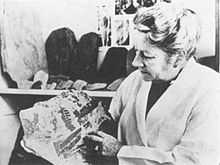
Edna P. Plumstead
- Kevin Padian (USA, 1951- ), known for interest in origins of flight and evolution of birds from therapod dinosaurs
- Miquel Crusafont i Pairó (Spain, 1910-1983), specialist in mammal bones
- Allison R. Palmer (USA, 1927- ), focused on the Cambrian period
- C. Phil Palmer (England)
- James Parkinson (England, 1755-1824)
- William Parks (Canada, 1868-1936)
- Bryan Patterson (England / USA, 1909-1979)
- Colin Patterson (England, 1933–1998)
- Gregory S. Paul (USA, 1954- ), known for illustration of theropod dinosaurs
- Frank Peabody (USA, 1914-1958), noted for research on fossil trackways and reptile and amphibian skeletal structure
- David P. Penhallow (USA / Canada, 1854-1910), paleobotanist
- Altangerel Perle (Mongolia, 1945- )
- Jaroslav Perner (Czech Republic, 1869-1947)
- Léon Pervinquière (France, 1873-1913)
- Josef Ladislav Píč (Czech Republic], 1847-1911)
- Elizabeth Philpot (England, 1780-1857)
- Guy Ellcock Pilgrim (England, 1875-1943)
- Irajá Damiani Pinto (Brazil, 1919-2014)
- Edna P. Plumstead (South Africa, 1903-1989), paleobotanist and defender of continental drift theory
- Auguste Pomel (France, 1821-1898)
- Jean-François-Albert du Pouget (France, 1818-1904)
- Vicentino Prestes de Almeida (Brazil, 1900-1954)
- Llewellyn Ivor Price (Brazil, 1905-1980)
- Donald Prothero (USA, 1954- )
- Mark Purnell (England)
Q
- Heinrich Quiring (Germany, 1883-1964)
R
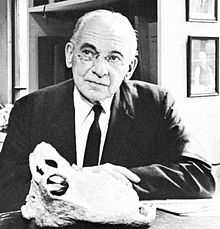
Alfred Sherwood Romer
- Guilherme Rau (Brazil, ???-1953)
- David M. Raup (USA, 1933- )
- Emily Rayfield (England)
- Osvaldo Reig (Argentina, 1929-1992)
- Roy Herbert Reinhart (USA, 1919-2005)
- Robert R. Reisz (Canada, 1947- ), specialist in the study of early amniote and tetrapod evolution
- Bernard Renault (botanist) (France, 1836-1904), specialist in regard to the anatomy of Carboniferous and Permo-Carboniferous flora.
- Charles Repenning (USA, 1922-2005), noted for his work on shrews, fossil rodents, modern pinnipeds and their extinct relatives, the Desmostylia
- Gregory Retallack (USA, 1951- )
- Charles E. Resser (USA, 1889-1943)
- August Emanuel von Reuss (Austria, 1811-1873)
- Armand de Ricqlès (France, 1938-1963), known for work in bone histology and its implications for the growth of dinosaurs
- Elmer S. Riggs (USA, 1869-1963), known for his work with the Field Museum of Natural History in Chicago, Illinois
- Josef Victor Rohon (Austria, 1845-1923)
- Alfred Romer (USA, 1894-1973), specialized in vertebrate evolution
- Marcus R. Ross (USA, 1976- ), vertebrate paleontologist
- Claudia Roth (France)
- Santiago Roth (Switzerland / Argentina, 1850-1924)
- John Ruben (USA), focused on the respiratory system of birds
- Rudolf Ruedemann (USA, 1864-1956)
- Bruce Runnegar (Australia, 1941- ), known for study of early life forms
- Dale Russell (Canada / USA, 1937- )
- Natalia Rybczynski (Canada)
S
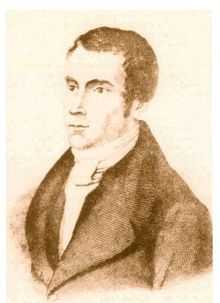
Philippe-Charles Schmerling
- John William Salter (England, 1820-1869)
- William J. Sanders (USA), known for study of fossil elephants
- Ivan Sansom (Wales), focused on the conodont palaeobiology and the early Palaeozoic radiation of vertebrates
- Gaston de Saporta (France, 1823-1895)
- Scott D. Sampson (Canada, 1961- )
- Henri Émile Sauvage (France, 1842–1917)
- Steven Schafersman (USA)
- Judith Schiebout (USA)
- Erich Maren Schlaikjer (USA, 1905-1972)
- Philippe-Charles Schmerling (Netherlands / Belgium, 1790-1836)
- Robert M. Schoch (USA)
- J. William Schopf (USA, 1941- )
- Frederick Schram (USA, 1943- )
- Charles Schuchert (USA, 1858-1942), invertebrate paleontologist and leader in paleogeography
- Mary Higby Schweitzer (USA), known for leading the groups that discovered the remains of blood cells in dinosaur fossils and later discovered soft tissue remains in the Tyrannosaurus rex specimen MOR 1125
- William Berryman Scott (USA, 1858-1947), vertebrate paleontologist specializing in mammals
- Samuel Hubbard Scudder (USA, 1837-1911)
- Harry Seeley (England, 1839-1909)
- Adolf Seilacher (Germany, 1925-2014), known for study of trace fossils and of the Ediacaran biota
- Jack Sepkoski (USA, 1948-1999)
- Paul Sereno (USA, 1957- )
- Ethel Shakespear (England, 1871-1946)
- Nathaniel Shaler (USA, 1841-1906)
- Charles Davies Sherborn (England, 1861-1942)
- Neil Shubin (USA, 1960- ), known for his discovery of Tiktaalik roseae
- Christian Sidor (USA)
- Gloria Jean Siebrecht (USA, 1940- )
- George Gaylord Simpson (USA, 1902-1984), expert on extinct mammals and their intercontinental migrations
- Martin I. Simpson (England), expert on Cretaceous fossil crustaceans
- Christopher P. Sloan (USA, 1954- )
- M. Paul Smith (England)
- Leonard Frank Spath (England, 1882-1957), specialist in malacology and ammonitology
- Zdeněk Špinar (Czech Republic, 1916-1995)
- Robert Masterman Stainforth (England, 1915-2002), known for his work on the application of planktonic foraminifera to worldwide stratigraphic correlation
- Herbert F. Standing (Madagascar)
- Steven M. Stanley (USA, 1941- ), known for his empirical research documenting the evolutionary process of punctuated equilibrium in the fossil record
- Charles Hazelius Sternberg (USA, 1850-1943)
- Charles Mortram Sternberg (USA / Canada, 1885-1981)
- Kaspar Maria von Sternberg (Czech Republic, 1761-1838)
- Ferdinand Stoliczka (Austria / Czech Republic, 1838-1874)
- Henry Stopes (England, 1852-1902)
- Marie Stopes (England, 1880-1958)
- J. Willis Stovall (USA, 1891-1953)
- Samuel Stutchbury (England, 1798-1859), known for co-discovery of Thecodontosaurus
- Hans-Dieter Sues (USA)
- William Elgin Swinton (Scotland / Canada)
T
- Mignon Talbot (USA, 1869-1950)
- Darren Tanke (Canada, 1960- )
- Philippe Taquet (France, 1940- ), specializes in dinosaur systematics of finds primarily in northern Africa
- Ian Tattersall (England / USA, 1945- )
- Mike P. Taylor (England, 1968- )
- Richard H. Tedford (USA, 1929-2011)
- Curt Teichert (Germany / USA, 1905-1996)
- Pierre Teilhard de Chardin (France, 1881-1955), took part in the discovery of Peking Man
- Geneviève Termier (France, 1917-2005)
- Henry Testot-Ferry (France, 1826-1869)
- Robert C. Thorne (USA, 1898-1960)
- Raymond Thorsteinsson (Canada, 1921-2012)
- Richard A. Thulborn (England), expert in dinosaur tracks
- Bruce H. Tiffney (USA), known for research on the evolution of flowering plants
- Ramsay Traquair (Scotland, 1840–1912). expert on fossil fish
- Juan Tavera (Chile, 1917-1991), known for work on marine invertebrate fossils
- Ronald Pearson Tripp (England, 1914-2001), specialized in trilobites
- Joseph Tyrrell (Canada, 1858-1957), discovered Albertosaurus
U
- Viktor Uhlig (Austria, 1857-1911)
- Edward Oscar Ulrich (USA, 1857-1944), invertebrate paleontologist specializing in Paleozoic fossils
- Franz Unger (Austria, 1800-1870)
V
- Pierre-Joseph van Beneden (Belgium, 1809-1894)
- Gerard Frederick van Tets (England / Canada / Australia, 1929-1995)
- Geerat J. Vermeij (Netherlands / USA, 1946- ), studied marine molluscs
- Édouard de Verneuil (France, 1805-1873)
- Patricia Vickers-Rich (USA / Australia, 1944- )
- Emily H. Vokes (USA, 1930- ), expert on Muricidae
- Elisabeth Vrba (USA, 1942- ), known for developing the turnover-pulse hypothesis
W
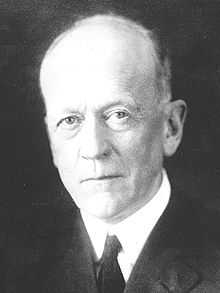
Charles Doolittle Walcott
- Charles Wachsmuth (USA, 1829-1896)
- C. H. Waddington (England, 1905-1975)
- Mary Wade (Australia, 1928-2005), known for study of the Ediacaran biota in South Australia
- Peter J. Wagner (USA, 1964- )
- Norman Arthur Wakefield (Australia, 1918-1972)
- Charles Doolittle Walcott (USA, 1850-1927), known for discovery of fossils in the Burgess Shale
- Alick Walker (England, 1925-1999)
- Cyril Walker (England, 1939-2009)
- Arthur Bache Walkom (Australia, 1889-1976), paleobotanist
- Xiaoming Wang (China / USA)
- Jindřich Wankel (Czech Republic, 1821-1897)
- David Ward (England, 1948- )
- Peter Ward (USA, 1949- )
- Matt J. Wedel (USA)
- Wesley Wehr (USA, 1929–2004), known for his studies of Cenozoic fossil floras in western North America
- Pei Wenzhong (China, 1904-1982)
- David B. Weishampel (USA, 1952- )
- Samuel Paul Welles (USA, 1907-1997)
- John W. Wells (USA, 1907-1994), focused on coral research
- Richard Gilbert West (England, 1926- )
- Charles M. Wheatley (USA, 1822-1882)
- Charles Abiathar White (USA, 1826-1910)
- Joseph Frederick Whiteaves (England / Canada, 1835-1909)
- Harry B. Whittington (England, 1916-2010), known for study of fossils from the Burgess Shale
- Christopher H. Whittle (USA, 1959- )
- Joan Wiffen (New Zealand, 1922-2009)
- James Steele Williams (USA, 1896-1957)
- Samuel Wendell Williston (USA, 1851-1918)
- Alice Wilson (Canada, 1881-1964)
- Jeffrey A. Wilson (USA)
- Tiberius Cornelis Winkler (Netherlands, 1822-1897)
- Henry Witham (England, 1779–1844), an early researcher into the internal structure of fossil plants
- Lawrence Witmer (USA)
- Thomas Wright (Scotland, 1809-1884)
- Jack A. Wolfe (USA, 1936-2005), best known for his studies of Tertiary climate in western North America through analysis of fossil angiosperm leaves
- Searles Valentine Wood (England, 1798-1880)
- Henry Woods (England, 1868-1952)
- Arthur Smith Woodward (England, 1864-1944), expert in fossil fish
- Henry Woodward (England, 1832-1921), known for study of fossil crustaceans and arthropods
- Amos Henry Worthen (USA, 1813-1888)
- Claud William Wright (England, 1917-2010)
- Andre Wyss (USA)
X
Y
- Yang Zhongjian (China, 1897-1979)
- Lorenzo Gordin Yates (USA, 1837-1909)
- Ivan Yefremov (Russia, 1908-1972), originator of taphonomy
- Xiaobo Yu (China)
- Yuan Wang (China)
Z
- Lindsay Zanno (USA)
- Otto Zdansky (Austria, 1894-1988)
- Charles René Zeiller (France, 1847-1915)
- Zhao Xijin (China)
- Zhou Ming-Zhen (China, 1918-1996)
- Zhou Zhonghe (China, 1965- )
- Jiri Zidek (Czech Republic / United States)
- Eduard Meine van Zinderen-Bakker (Netherlands / South Africa, 1907-2002)